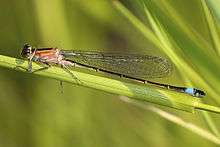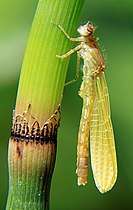Blue-tailed damselfly
The blue-tailed damselfly or common bluetail (Ischnura elegans) is a damselfly, belonging to the family Coenagrionidae.[1]
| Blue-tailed damselfly | |
|---|---|
_male_adult.jpg) | |
| Mature male | |
 | |
| Female, form rufescens | |
| Scientific classification | |
| Kingdom: | Animalia |
| Phylum: | Arthropoda |
| Class: | Insecta |
| Order: | Odonata |
| Suborder: | Zygoptera |
| Family: | Coenagrionidae |
| Genus: | Ischnura |
| Species: | I. elegans |
| Binomial name | |
| Ischnura elegans (Vander Linden, 1820) | |
| Synonyms | |
| |
Subspecies and varieties
Subspecies and varieties include:[2]
- Ischnura elegans ebneri Schmidt, 1938
- Ischnura elegans elegans (Vander Linden, 1820)
- Ischnura elegans pontica Schmidt, 1939
- Ischnura elegans f. infuscans
- Ischnura elegans f. infuscans-obsoleta
- Ischnura elegans f. rufescens
- Ischnura elegans f. typica
- Ischnura elegans f. violacea
Habitat
These damselflies can be found in a wide range of lowland environments, with standing and slow flowing waters, brackish and polluted water.[4]
Description
Ischnura elegans can reach a body length of 27–35 millimetres (1.1–1.4 in) and a wingspan of about 35 millimetres (1.4 in). Hindwings reach alength of 14–20 millimetres (0.55–0.79 in).[5] Adult male blue-tailed damselflies have a head and thorax patterned with blue and black. There is a bi-coloured pterostigma on the front wings. Eyes are blue.[4] They have a largely black abdomen with very narrow pale markings where each segment joins the next. Segment eight, however, is entirely pale blue.[4] At rest, the wings of most damselfly species are held back together, unlike dragonflies, which rest with their wings out flat. The thorax of juvenile males has a green tinge.[5]
Female blue-tailed Damselflies come in a variety of colour forms.[4] Juveniles may be salmon pink, form rufescens; violet, form violacea and a pale green form. The colour darkens as the damselfly ages. Mature females may be blue like the male, form typica; olive green thorax and brown spot, form infuscans or pale brown thorax and brown spot, form infusca-obseleta.[5][4]
Biology and behavior
Adults fly from April to September to early October.[4] The adult damselflies prey on small flying insects, caught using their legs like a basket to scoop the prey up while flying, or insects taken from leaves. Damselfly nymphs are aquatic, and prey on small aquatic insects or other aquatic larvae.
A male can try to interfere with a mating pair, by attaching itself to the mating male.The females always lay their eggs on the floating parts of the plants without any involvement of the male.
Blue-tailed Damselflies are superb fliers and can alter each of their four wing's kinematics in order to maneuver. A recent study has shown that they can compensate for a whole wing loss and even successfully maneuver and catch prey.[6]
Gallery
_mating%2C_female_typica_2.jpg) Mating, female f. typica
Mating, female f. typica_nymph.jpg) nymph
nymph emerging
emerging_immature_male.jpg) Immature male
Immature male_teneral_female_rufescens.jpg) teneral female form rufescens
teneral female form rufescens_female_rufescens.jpg) Female form rufescens
Female form rufescens_female_violacea.jpg) Female form violacea
Female form violacea_female_rufescens-obsoleta_2.jpg) Female form rufescens-obsoleta
Female form rufescens-obsoleta
References
- Bisby F.A., Roskov Y.R., Orrell T.M., Nicolson D., Paglinawan L.E., Bailly N., Kirk P.M., Bourgoin T., Baillargeon G., Ouvrard D. Catalogue of life
- Biolib
- Fauna europaea
- BDS - British Dragonfly Society
- L. Watson and M. J. Dallwitz British Insects: the Odonata (Dragonflies and Damselflies
- Kassner, Ziv; Dafni, Eyal; Ribak, Gal (2016-02-01). "Kinematic compensation for wing loss in flying damselflies". Journal of Insect Physiology. 85: 1–9. doi:10.1016/j.jinsphys.2015.11.009. PMID 26598807.
External links

